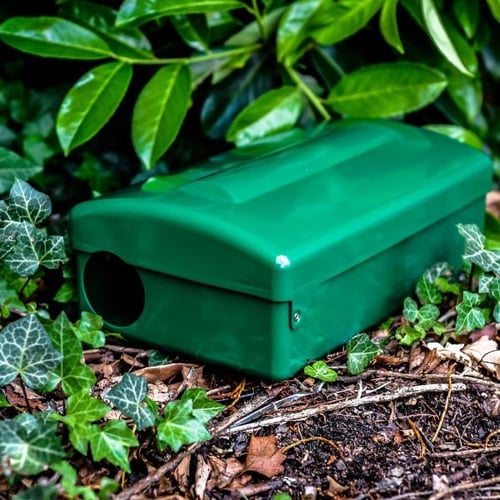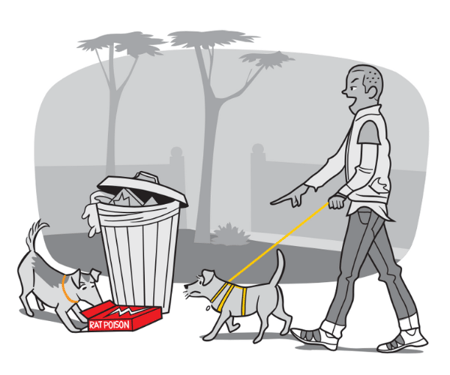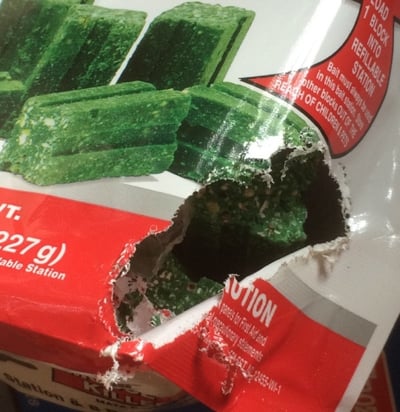 If you know or suspect your pet has consumed even a small amount of rat poison, call your veterinarian, a pet poison hotline, or an Animal ER IMMEDIATELY.
If you know or suspect your pet has consumed even a small amount of rat poison, call your veterinarian, a pet poison hotline, or an Animal ER IMMEDIATELY.
Time is of the essence, so take action quickly!
Even if you don't see any symptoms, which can take a few days to become noticeable, bad things could be brewing internally.
So, don't delay in getting a veterinary evaluation. When appropriate care is given promptly, most pets survive.
Skip to section:
What to Tell the Veterinarian or a Pet Poison Hotline
When a pet has been or is suspected to be poisoned, time is of the essence. Delays in treatment can cause damage to their organs and possibly have fatal results.
Contact your veterinarian as soon as you are aware or suspect poisoning of your pet with a rodenticide.
In order for a veterinarian to best help your pet, you will need to provide them with as much information as possible so they can determine the best course of treatment.
Some information the veterinary professionals will need:
-
- When your pet was exposed – the day and time
- What your pet weighs
- The brand name and manufacture of the product consumed
- The active ingredients and their concentration (see list of possible active ingredients and their level of toxicity)
Note: Appearance alone will not allow identification of the product’s active ingredients. Most products look very similar. - The size of the package. The estimated amount of product consumed. (How much appears to be missing from the container/package?)
Note: The specific amount of poison it takes to be lethal to a pet is dependent upon the type of poison (some are more poisonous than others) and the weight and size of the pet. - Is your pet showing any signs or symptoms? And if yes, which ones?
- When your pet was exposed – the day and time
Questions? If you need to chat with a veterinarian right now, Click here
Depending on the product consumed and the length of time it will take you to arrive at the veterinary hospital, your veterinarian may instruct you to induce vomiting. Do not induce vomiting unless instructed to do so, and NEVER induce vomiting if your pet is having seizures or is unconscious.
When going to the vet, bring the packaging with you. These poisonous products come in different colors and forms (pellets, blocks – both hard and soft types, grains/meal, gels, and liquids). The packaging is so helpful for the veterinary team to see so they can see the active ingredients, which determines the course of treatment they will offer your pet.
If the packaging isn’t available, try to (safely) bring some of the poison along with you for the veterinary team to see — they may just be able to tell which one it is by its appearance.
At the Veterinary Hospital
When you arrive at the veterinary hospital, you will receive a barrage of questions, and the entire staff will start performing treatments for your pet immediately.
While it all may seem overwhelming, your answers will help them, and it will guide the course of care your pet needs.
Following an initial assessment, the veterinary team will start supportive care and diagnostic tests, which include intravenous fluids, medications to control any symptoms that are present at the time of arrival, and blood work.
Vomiting will be induced if it has been within 2 hours of ingestion, but in some cases, it will be attempted if it has been within 4 hours. Your veterinarian will not induce vomiting if your pet is unconscious or having seizures.
In some cases, your pet may be sedated to have gastric lavage performed. This helps further remove toxins from the stomach. A tube will be passed into your pet’s stomach. Water will then be passed down the tube into the stomach.
Once filled, the stomach will be gently compressed to remove the water. When all the contaminants appear to be removed, your pet will likely be given activated charcoal and cathartics to assist in further decontamination.
Depending on the type of rodenticide and its effects on the body, medications will be given to counteract them following decontamination. For example, Vitamin K is given for a period of 2 to 4 weeks following exposure to anticoagulant rodenticides.
In cases of poisoning with cholecalciferol, your pet will need to have blood work for a few weeks following exposure to monitor calcium levels in their blood, be on medications to increase urination and be on a low-calcium diet.
Depending on your pet’s symptoms when they arrive at the hospital, their blood work results, and their response to treatment, they may need to be hospitalized for a few days for continued supportive care and management of symptoms. Some pets may require blood transfusions and special tests to monitor blood clotting.
Signs and Symptoms of Rat Poisoning in Dogs and Cats
When your pet consumes rat poison, it can result in internal bleeding, organ damage, kidney failure, and, if enough is consumed or treatment is delayed, death.
A pet's particular symptoms will depend on the type of poison eaten (the active ingredient), as well as the amount eaten, your pet's weight, and the amount of time that has passed since they ate it.
Typically, signs appear 2 to 10 days after ingestion. The reason for the delay in the development of symptoms is that it takes about 1 to 2 days for the poison to use up the vitamin K1 and clotting factors and an additional 3 to 7 days for the signs of blood loss to be evident. Blood loss may be happening inside your pet, so you may not notice anything externally.
Possible signs of rodenticide poisoning in pets:
- bruising or petechiation (small, pinpoint red dots — most typically seen on the gums, inner ear, or hairless part of the belly)
- pale gums
- seizures
- shaking
- muscle tremors
- vomiting (possibly with blood)
- coughing (possibly with blood)
- abdominal distension (stomach looking bloated)
- lethargy, inactivity, or weakness
- breathing problems (e.g., difficulty breathing, rapid breathing)
- rapid heart rate/pulse
- a big increase in thirst and urination
- blood or dark discoloration of the urine
- change in color of their bowel movements – can be dark black and "tarry," blood red, or even bright green or blue (the green or blue color comes from the baits themselves)
- uncontrolled bleeding (often seen as nosebleeds or easy bruising)
Note: You may or may not notice bleeding. In some cases, bleeding will be coming from the mouth or nose. But generally, it is often not noticed because it occurs internally in their chest, lungs, abdomen, gastrointestinal tract, and joints.

All Rat and Mouse Poisons Are Not the Same
While many of the more common rodenticides kill by causing prolonged bleeding, not all do! Some kill by causing kidney failure, while others kill through their devastating effect on the cellular metabolism throughout the body.
This difference in "mode of action" is extremely important, as they each carry their own prognosis for recovery and require different treatments.
The Difference Between First- and Second-Generation Rodenticides
Additionally, rodenticides are referred to as first or second-generation, based on when they were developed. Those produced before the 1970s (e.g., Chlorophacinone or Warfarin) are referred to as first-generation rodenticides. When they are eaten for several days, their toxicity increases, which then leads to death.
The rodenticides produced after the 1970s are called second-generation rodenticides. These are more toxic than first-generation products and accumulate in the animal's tissues. Death is likely with a single feeding. These second-generation poisons are only available for commercial pest control. So, they could be found in farming or agricultural areas, as well as other commercial settings.
There are some "natural" DIY rat poisons that people use that are very harmful to pets, as well. Check out our article, Dangerous & Pet-Safe Rat and Mouse Baits, for more detail on the types of poisons and how they affect dogs and cats.
A Unique Rodenticide
Alpha-chloralose is not legally available in the United States, but it is important to be aware of it if you and your pet visit or live in countries outside the US. It can be obtained illegally online. Therefore, exposure of pets to this product should be anticipated.
In many countries, alpha-chloralose (trade name Alphakil and Somio) is used to kill or repel birds and as an anesthetic agent for laboratory animals. It is also used as a rodenticide.
The Environmental Protection Agency (EPA) proposed in late 2019 that alpha-chloralose be registered as a rodenticide.
Its exact mechanism of action is unknown, but depending on the dose, it can have a stimulating or depressive effect on the central nervous system.
Cats are more sensitive to alpha-chloralose than dogs. The minimum lethal dose for cats is 100mg/kg, and for dogs, it is 600 to 1,000 mg/kg.
The bait is not palatable, and therefore, most pets don’t tend to eat it out right (but there are always exceptions!). Ingestion of rodents or birds that have eaten the poison can result in toxicosis of pets if they consume them.
The clinical signs can last one to three days and include:
- Abnormal gait
- Tremors
- Cranial nerve deficits such as a head tilt, rolling or falling, abnormal eye movements
- Constricted pupils
- Excessive salivation
- Decreased heart rate
- Behavioral changes
- Stupor
- Low body temperature (hypothermia)- more common in cats
- Changes in respiration
- Extreme drowsiness or sleeping long periods
- Low blood pressure
- Seizures
- Coma-more common in dogs
Since there is no antidote (remedy) for this toxin, treatment involves managing the presenting symptoms and supportive care. If treated early, recovery is favorable.
The Poisoned Rodent Can Be a Problem
Rats and mice that eat then die from rodenticides are dangerous to your pets if they eat that poisoned rodent. Rats and mice can take days to die. For days, they may be moving slowly or lying, looking dead but still breathing. It's truly a horrible way for them to die, and they can pose a risk to your pets.
If the rodent consumed a first-generation rodenticide (see above for the details on what is a first-generation poison), there is generally less of a reason to be concerned about pet poisoning since they are lower in toxicity and the poison is no longer present in the rodent’s body after several hours.
However, the potential risk is higher for smaller dogs and cats. Also, if you use rodenticides over an extended period and your pets are big hunters, they are at risk of secondary poisoning from repeated exposure, especially if they eat the rodents soon after they were poisoned.
If the rodent consumed one of the newer or second-generation rodenticides (e.g., Bromadiolone, Brodifacoum, and Difethialone), these substances remain in the tissue longer, and that means they pose a greater threat to pets and other animals. If the rat consumed a large quantity, it would accumulate in the rat’s liver.
If a pet consumes the rat’s liver, the risk of toxicity is real. The good news is that residential use of second-generation rat poisons has been banned. However, it is still available for commercial pest control.
Be sure to ALWAYS properly dispose of rodents that have been poisoned as one way to eliminate secondary poisoning. This can be challenging, as rodents poisoned in another location (i.e., from your neighbor's rat bait) can end up dying in your yard.
Questions? If you need to chat with a veterinarian right now, Click here
How to Prevent an Accidental Rodenticide Poisoning

It's not just in and around your home where you have to worry about your pets getting into rat and mouse baits. Even if you’re not using these poisons yourself, others are, especially during the fall and winter.
Your neighbors, local parks, schools, and businesses may be using them to ward off rodents from entering inside during the colder months.
Keep this in mind, too, when traveling with your pets, as some hotels or rental homes may use rodenticides inside or on their grounds!
How to Protect Your Pets from Rodenticides
- Keep your dogs under leash control, and don’t let them scavenge on walks — especially around parks, schools, and outside of restaurants.
- Keep your dogs in fenced-in yards.
- Keep cats indoors. If you allow them outdoors, monitor their behavior and health closely.
- If you use or store rodenticides in your home or garage, be aware of what types you (or your landlord) are using. Always keep them well out of reach of your pets. This applies both to the pieces of poison laid out (or placed in a bait station), as well as the rest of what’s left in the box or bag! See the list of active ingredients below.
- Work only with exterminators who use pet-safer methods of rodent control.
- Ask your neighbors not to leave any rat or mouse poisons (store-bought or DIY type) in their yard or to let you know in advance if they plan to.
- Inquire about and double-check in and around any hotels, motels, or rental properties you stay in with your pets while traveling.

- Inquire about the presence of rodenticides prior to moving into a new house or apartment. Consider making removal of any rodenticides being used as a condition of the purchase or rental agreement — your pet being poisoned by a rodenticide that you didn’t even know was there is a very unwelcome housewarming gift!
True Story: A family with two Jack Russell Terriers moved into a new house. Two weeks after moving in, they had to bring their dogs to the ER for accidental rat poisoning. The dogs discovered and ate blocks of rat poison that had been left behind under the deck of the house by the previous owners.
Fortunately, they both survived, but it was touch and go and certainly took a toll –– both financially and emotionally –– on the dogs' family.
Rodenticide Active Ingredients List
Highly Toxic Rat Poison Ingredients
- Aluminum phosphide
- Arsenic
- Barium carbonate
- Bromethalin – dose dependent and no antidote (treatment)
- Elemental phosphorus
- Sodium monofluoracetat
- Strychnine
- Thallium
- Zinc phosphide
- Rarely used or banned dangerous toxins
- Aldicarb
- Alpha-chloralose
- Disulfotetramine (TETS, tetramine)
- Pyrinuron
- Tetramethylen
Moderately Toxic
- Alpa-naphthyl thiourea (ANTU)
- Cholecalciferol
- Diaphacinone
- Dipazin
- Diphenacin
Toxic
- Brodifacoum
- Bromodialone
- Chlorophacinone
- Difenacoum
- Difethialone
- Norbormide
- Red squill
- Superwarfarin
- Warfarin
NOTE: Even though the third category may seem "less" toxic, pets can and will die if not treated promptly.

Rodenticide is so tempting for rodents (and pets) that they'll even eat through the packaging to get at it.
ASPCA's Animal Pet Poison Control Center tracks the top toxicity calls to their poison hotline across the United States. In 2016, rat bait poisoning was the top toxicity in 24 states! We suspect it hasn't changed much since then. Take care, and if you're using rat poison in your yard or home, check out our recommended pet-safer options.



